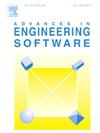利用机器学习优化飞机机翼气动性能
IF 4
2区 工程技术
Q2 COMPUTER SCIENCE, INTERDISCIPLINARY APPLICATIONS
引用次数: 0
摘要
本研究为跨音速飞机机翼的气动设计提出了一个快速而可靠的优化框架。结合计算流体动力学(CFD)和机器学习(ML),该框架成功应用于美国国家航空航天局(NASA)提出的通用研究模型(CRM)基准飞机。该框架依靠一系列自动 CFD 仿真,从空气动力学角度评估了 CRM 机翼的不少于 160 种平面形状变化。该数据库用于培养 ML 代理模型,并为此探索了两种特定算法,即极端梯度提升算法 (XGB) 和轻梯度提升机 (LGBM)。在使用该数据库的 80% 进行训练并使用剩余的 20% 进行测试后,将使用 ML 代理来探索更大的设计空间,然后使用依赖于多目标遗传算法 (MOGAO) 的优化框架来推断其最佳值。然后,通过 CFD 对每个基于 ML 的优化方案进行模拟,以确认其气动性能,并将其与传统的、完全基于 CFD 的优化方案进行比较。比较结果非常有利,基于 ML 的最佳方案与基于 CFD 优化的方案表现出相似的性能(例如,升阻比提高了 14%),而 CPU 成本只有后者的一半。总之,这项研究证明了基于 ML 的方法在优化飞机机翼方面的潜力,从而为采用更具颠覆性的数据驱动飞机设计模式铺平了道路。本文章由计算机程序翻译,如有差异,请以英文原文为准。
Aerodynamic optimization of aircraft wings using machine learning
This study proposes a fast yet reliable optimization framework for the aerodynamic design of transonic aircraft wings. Combining Computational Fluid Dynamics (CFD) and Machine Learning (ML), the framework is successfully applied to the Common Research Model (CRM) benchmark aircraft proposed by NASA. The framework relies on a series of automated CFD simulations, from which no less than 160 planform variations of the CRM wing are assessed from an aerodynamic standpoint. This database is used to educate an ML surrogate model, for which two specific algorithms are explored, namely eXtreme Gradient Boosting (XGB) and Light Gradient Boosting Machine (LGBM). Once trained with 80 % of this database and tested with the remaining 20 %, the ML surrogates are employed to explore a larger design space, their optimum being then inferred using an optimization framework relying on a Multi-Objective Genetic Algorithm (MOGAO). Each ML-based optimal planform is then simulated through CFD to confirm its aerodynamic merits, which are then compared against those of a conventional, fully CFD-based optimization. The comparison is very favourable, the best ML-based optimal planform exhibiting similar performances as its CFD-optimized counterpart (e.g. a 14 % higher lift-to-drag ratio) for only half of the CPU cost. Overall, this study demonstrates the potential of ML-based methods for optimizing aircraft wings, thereby paving the way to the adoption of more disruptive, data-driven aircraft design paradigms.
求助全文
通过发布文献求助,成功后即可免费获取论文全文。
去求助
来源期刊

Advances in Engineering Software
工程技术-计算机:跨学科应用
CiteScore
7.70
自引率
4.20%
发文量
169
审稿时长
37 days
期刊介绍:
The objective of this journal is to communicate recent and projected advances in computer-based engineering techniques. The fields covered include mechanical, aerospace, civil and environmental engineering, with an emphasis on research and development leading to practical problem-solving.
The scope of the journal includes:
• Innovative computational strategies and numerical algorithms for large-scale engineering problems
• Analysis and simulation techniques and systems
• Model and mesh generation
• Control of the accuracy, stability and efficiency of computational process
• Exploitation of new computing environments (eg distributed hetergeneous and collaborative computing)
• Advanced visualization techniques, virtual environments and prototyping
• Applications of AI, knowledge-based systems, computational intelligence, including fuzzy logic, neural networks and evolutionary computations
• Application of object-oriented technology to engineering problems
• Intelligent human computer interfaces
• Design automation, multidisciplinary design and optimization
• CAD, CAE and integrated process and product development systems
• Quality and reliability.
 求助内容:
求助内容: 应助结果提醒方式:
应助结果提醒方式:


